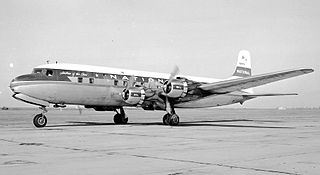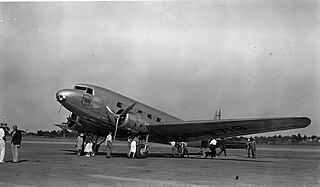
The Bermuda Triangle, also known as the Devil's Triangle, is a loosely defined region in the western part of the North Atlantic Ocean where, according to an urban legend, a number of aircraft and ships are said to have disappeared under mysterious circumstances. The idea of the area as uniquely prone to disappearances arose in the mid-20th century, but most reputable sources dismiss the idea that there is any mystery.

The Tenerife airport disaster occurred on 27 March 1977, when two Boeing 747 passenger jets collided on the runway at Los Rodeos Airport on the Spanish island of Tenerife. The collision occurred when KLM Flight 4805 initiated its takeoff run in dense fog while Pan Am Flight 1736 was still on the runway. The impact and the resulting fire killed all 248 people on board the KLM plane and 335 of the 396 people on board the Pan Am plane, with only 61 survivors in the front section of the latter aircraft. With a total of 583 fatalities, the disaster is the deadliest accident in aviation history.
This is a list of aviation-related events from 1980.
This is a list of aviation-related events from 1969.
British South American Airways (BSAA) was a state-run airline of the United Kingdom in the mid-to-late 1940s responsible for services to the Caribbean and South America. Originally named British Latin American Air Lines, it was renamed before services started in 1946. BSAA operated mostly Avro aircraft: Yorks, Lancastrians and Tudors and flew to Bermuda, the West Indies, Mexico and the western coast of South America. After two high-profile aircraft disappearances it was merged into the British Overseas Airways Corporation at the end of 1949.

Flight 19 was the designation of a group of five General Motors TBM Avenger torpedo bombers that disappeared over the Bermuda Triangle on December 5, 1945, after losing contact during a United States Navy overwater navigation training flight from Naval Air Station Fort Lauderdale, Florida. All 14 naval aviators on the flight were lost, as were all 13 crew members of a Martin PBM Mariner flying boat that subsequently launched from Naval Air Station Banana River to search for Flight 19.

The Sikorsky S-42 was a commercial flying boat designed and built by Sikorsky Aircraft to meet requirements for a long-range flying boat laid out by Pan American World Airways in 1931. The innovative design included wing flaps, variable-pitch propellers, and a tail-carrying full-length hull. The prototype first flew on 29 March 1934, and, in the period of development and test flying that followed, quickly established ten world records for payload-to-height. The "Flying Clipper" and the "Pan Am Clipper" were other names for the S-42.

National Airlines Flight 2511 was a United States domestic passenger flight from New York City to Miami, Florida. On January 6, 1960, the Douglas DC-6 serving the flight exploded in midair. The National Airlines aircraft was carrying 5 crew members and 29 passengers, all of whom perished. The Civil Aeronautics Board investigation concluded that the plane was brought down by a bomb made of dynamite. No criminal charges were ever filed, nor was the blame for the bombing ever determined, though a suicide bombing is suspected. The investigation remains open.

Pacific Air Lines Flight 773 was a Fairchild F27A Friendship airliner that crashed on May 7, 1964, near Danville, California, a suburb east of Oakland. The crash was most likely the first instance in the United States of an airliner's pilots being shot by a passenger as part of a murder–suicide. Francisco Paula Gonzales, 27, shot both pilots before turning the gun on himself, causing the plane to crash, killing all 44 aboard.

Pan Am Flight 845 was a scheduled international passenger flight between Los Angeles and Tokyo, with an intermediate stop at San Francisco. The flight was operated by a Boeing 747 registered N747PA and named Clipper America.

Cubana de Aviación Flight 493, registration CU-T188, was a Douglas DC-4 en route from Miami, Florida, to Havana, Cuba, on April 25, 1951. A US Navy Beechcraft SNB-1 Kansan, BuNo 39939, was on an instrument training flight in the vicinity of Naval Air Station Key West, Florida, at the same time. The two aircraft collided in mid-air over Key West, killing all 43 aboard both aircraft.

Pan Am Flight 7 was a westbound round-the-world flight operated by Pan American World Airways. On November 8, 1957, the Boeing 377 Stratocruiser 10-29 serving the flight, named Clipper Romance of the Skies, crashed in the Pacific Ocean en route to Honolulu International Airport from San Francisco. The crash killed all 36 passengers and eight crew members.

West Coast Airlines Flight 956 was a scheduled commercial flight in the western United States which crashed on October 1, 1966, approximately 5.5 miles (9 km) south of Wemme, Oregon, southeast of Portland. Thirteen passengers and five crew members were aboard, but none survived. In its first week of service, the aircraft was destroyed by the impact and subsequent fire.

Star Tiger was an Avro Tudor IV passenger aircraft owned and operated by British South American Airways (BSAA) which disappeared without a trace over the Atlantic Ocean while on a flight between Santa Maria in the Azores and Bermuda in the early morning of 30 January 1948. The loss of the aircraft, along with that of BSAA Avro Tudor Star Ariel in 1949, remains unsolved, with the resulting speculation helping to develop the Bermuda Triangle legend.

Star Ariel was an Avro Tudor Mark IVB passenger aircraft owned and operated by British South American Airways (BSAA) which disappeared without a trace over the Atlantic Ocean while on a flight between Bermuda and Kingston, Jamaica, on 17 January 1949. The loss of the aircraft, along with that of BSAA Avro Tudor Star Tiger in January 1948, remains unsolved, with the resulting speculation helping to develop the Bermuda Triangle legend.

The crash of TWA Flight 8 involved a Transcontinental & Western Air Douglas DC-2. On March 1, 1938, during a scheduled passenger flight from San Francisco to Winslow, Arizona, TWA's interstate hub, the flight encountered severe weather. The pilot radioed his intention to land in nearby Fresno. The aircraft subsequently crashed on a mountain in Yosemite National Park, and was found three months later.

On 11 September 1990, a Faucett Perú Boeing 727 airliner, registered OB-1303, disappeared in an area of the Atlantic Ocean approximately 180 miles southeast of Cape Race, Newfoundland, Canada. The aircraft was being ferried back from Malta to Peru after having been leased to Air Malta, and had six crewmembers on board as well as ten passengers consisting of airline employees and their families. The last contact with the crew was a distress message stating that the aircraft had run out of fuel and that they were preparing to ditch. The aircraft was hundreds of miles off course at the time. Nothing more was ever heard from the flight, and no trace of the aircraft or any of the occupants has since been found.













